Classics 2200 - Midterm 1
1/157
There's no tags or description
Looks like no tags are added yet.
Name | Mastery | Learn | Test | Matching | Spaced |
|---|
No study sessions yet.
158 Terms
Why do myths change?
To reflect the culture and audience that receive them
What is μῦθος?
mythos. It is a spoken word, an utterance, a thing that is said
What is a myth? (definition)
A traditional shared narrative.
Narrative: story that has a plot / shape to it
Traditional shared: Myths are narratives that are shared throughout a common culture
How were greek myths communicated / passed down / transmitted?
Orally!
This is because people were illiterate
All the stories that have been written down were first stories that had been shared orally for years
Because these myths were orally translated, it means we have no idea who original authors were
What is myth 'transmissed' through
Space and time
Because these stories get told through space and time, they change
What do myths do for people?
Myths express, reinforce, justify and challenge cultural values, practices, desires and fears
Myths are a way for a culture to make sense of the unknown, the inexplicable, and the mysterious
What are the different types of myths?
• Divine
• Legend / Saga
• Folktale
• Fable
What are the defining characteristics of divine myth?
Divine myths explain / reflect the natural universe, Greek social structures, and the characters are anthropomorphic (look-like humans)
As in, the myth will probably be about stuff like stars, earthquake, rainbows, weather, vegetation, tidal waves (natural phenomena) and reflect Greek social structure by having a patriarchy or aristocracy.
Basically, if it's a myth that has a god in it, it's probably divine.
Example --> The Greeks used Zeus to explain why they had lightning. Whenever he was mad, he threw lightning bolts, which is why they got lightning
What are the defining characteristics of legend?
Legends explain historical events, such as the Trojan War.
Other examples include the founding of cities (how cities get founded), wars, hereditary kingships
Whereas divine myths are about the gods, legends often /feature/ gods but are mainly about /EXPLEMENTARY HUMANS/ who are superior in one way or another (e.g. Achilles, Theseus)
These superior human beings are the main characters of these legends. They usually have one parent that's divine, lucky bastards
PHOTO: Zeus's lightning bolt. Represents divine myth
What's happening in this photo?

PHOTO: Odysseus blinding the cyclops. Represents folklore

What are the defining characteristics of folklore?
Folklore is a story that has inverted power structures. E.g. slaying a monster, rags to riches, overthrowing a tyrant
Major character is a normal human being, sometimes a trickster.
Happy endings!
Basically, a story about an underdog who uses his cleverness to get the better of a power structure.
What are the defining characteristics of fable?
Often a simple didactic story involving animals that teach a moral lesson.
Characters are animals with human characteristics
Didactic: teaches a simple lesson about everyday moral behaviour
Describe the myth of the fox and the crow. What type of myth is it?
Fable
Basically, Fox wants the cheese in the crow's mouth, so she uses flattery
"Oh crow, I would love to hear you sing"
Crow is so flattered that she forgets there's cheese in her mouth, opens her mouth to sing, and the cheese falls into the fox's mouth
Basically, if it has a sentence like "and the moral of the story is ... (do not listen to flattery)" then it's a fable
Quickly tell me everything about the Minoan civilization.
- THREE MOTIFS: Female figurines, bull imagery, double-axe (labrys)
- Existed 3000 BCE - 1400 BCE
- Lived on the island of Crete
- Non-indoeuropean, and therefore NOT GREEK (had a different alphabet from greeks)
- Dominated by Greeks, but NOT GREEK
- Lived in open palaces (e.g. Knossos) --> shows that they were not afraid of land military attack, and had a strong navy
- Excellent plumbing, yo
This is a reconstructed photo of what the palace of Knossos would have looked like. Knossos is Minoan

This is what the actual Knossos palace looks like. Remember, Knossos palace is on island of Crete, and is of the Minoan civilization - who were not Greek!
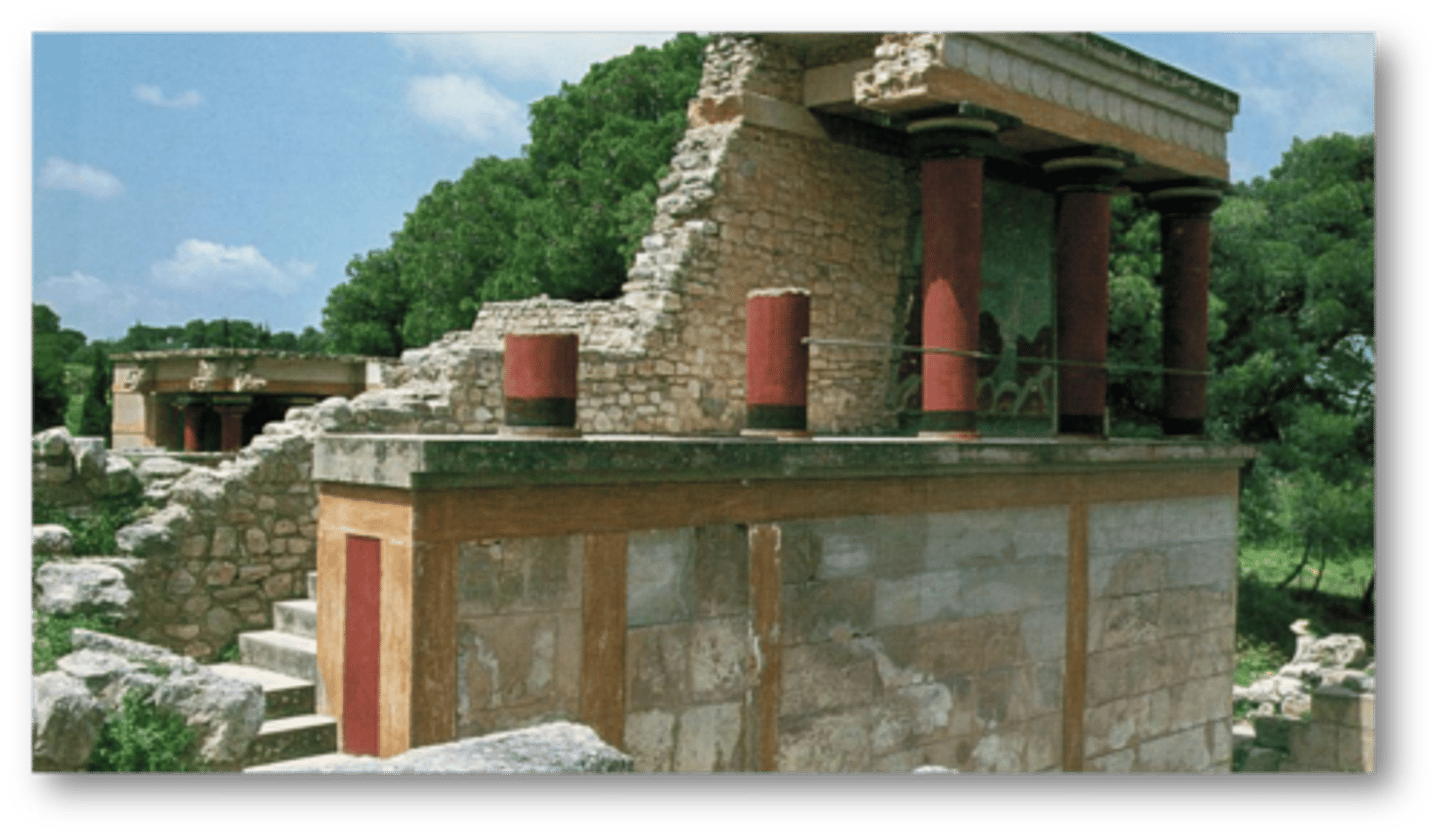
Jumping bull fresco. Minoan, found at Knossos palace

These are the Horns of Consecration found at Knossos. Minoan. Epitome of their iconography - bull horns everywhere! Double axe! Breasts!
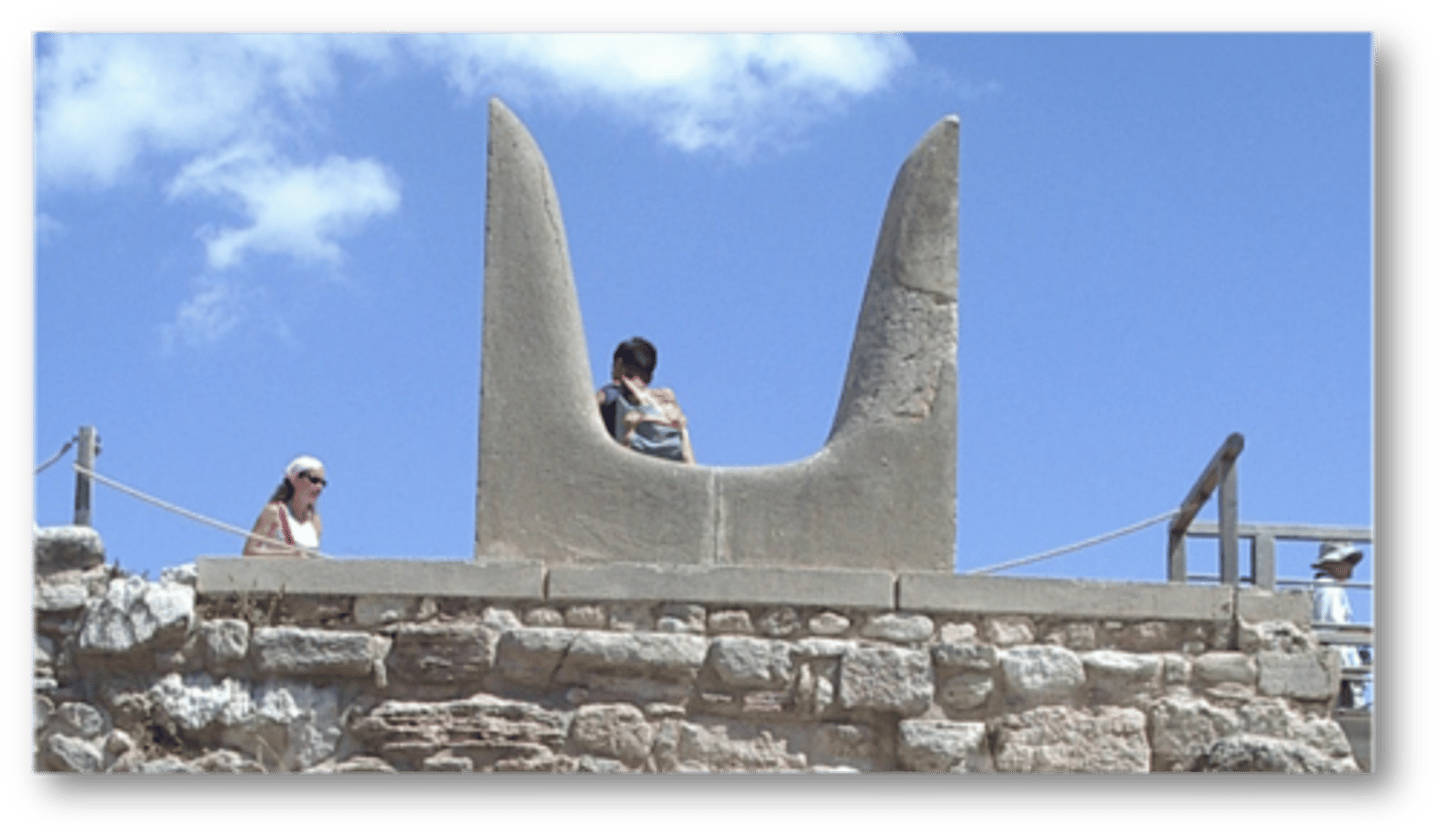
This is the Minoan double-axe, or labrys.
The axe, females, and bullhorns are the 3 thematic motifs in Minoan culture and art.

Quickly tell me everything about the Mycenaean civilization.
- Existed 1650 BCE -1150 BCE
- WERE Indoeuropean, so WERE GREEK (ancestors of Greeks, if you will)
- Built many crazy fortress palaces on the tops of hills (e.g. Mycenae palace)
- Lots of mythic heros (e.g. Nestor, Menelaus) come from Mycenaean cities
- Aristocratic social hierarchy
- Absorbed some elements of Minoan culture
- Wrote in Linear B alphabet, which was good for lists, so we have lists of the names of their gods, but not any actual writing
- No idea why their civilization went to shit (war? nature?)
This is the Lions Gate at Mycenae. 13th BCE
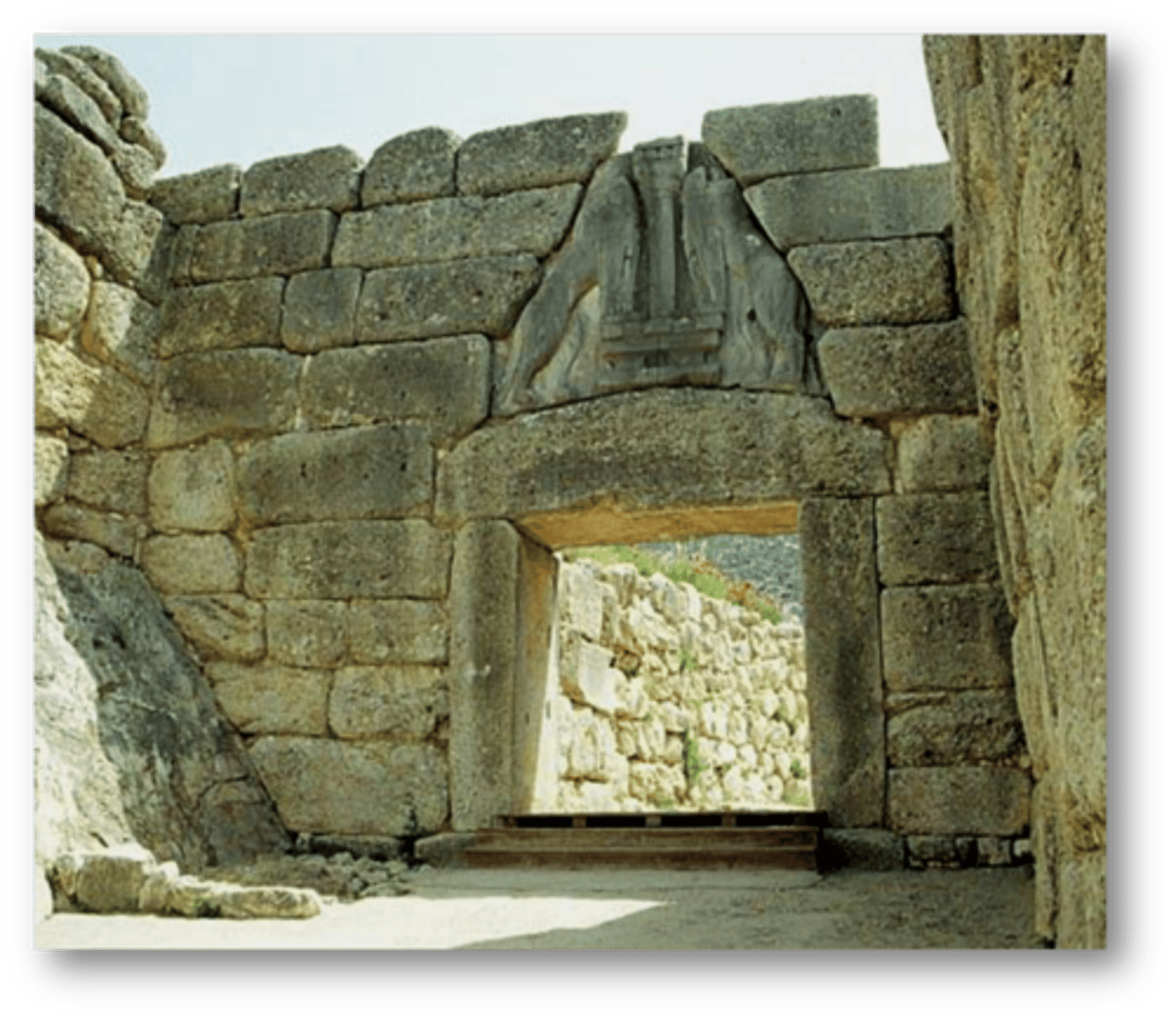
PHOTO: What is this script? Which civilization used it?
Linear B, Mycenaean

Quickly describe what happened in the Dark Ages
Everything went to shit
- 1100BCE - 800 BCE
- Population declined
- Economic decline
- People loss their literacy and became illiterate again
- Quality of artifacts was poor
- Low quantity of evidence as well
- People emigrated to Asia Minor
Quickly describe the Archaic Period
Things came back to not-shit after the Dark Ages!
800 BCE - 480 BCE
- Rise in trade and travel
- People became literate again -- adopted a Phoenician alphabet
- Interest in science increased
- City-states grew and prospered
What happened, culturally
- Homer, Hesiod, and lyric poetry was written in this time
- Olympics Games started in 776 BCE
- Sculptures started getting influenced by Egypt
- Persian Wars
This is a photo of a Kouros from the Archaic period. 530 BCE

Briefly describe the Classical Period.
Explosion of arts and culture at Athens. Athens became the epicenter for all things relevant
480 BCE - 323 BCE
- Athens was dominant player in Greek confederacy
- Got their empire based on navy
- Pericles was a major statesman
- Art, drama, architecture, education flowered
- Aeschylus, Sophocles, Euripides, Plato all existed in this time
- Democracy evolved
- Peloponnesian Wars 431-404 BCE
- Alexander the Great 356-323 BCE
PHOTO: Theater at Epidaurus. Hellenistic
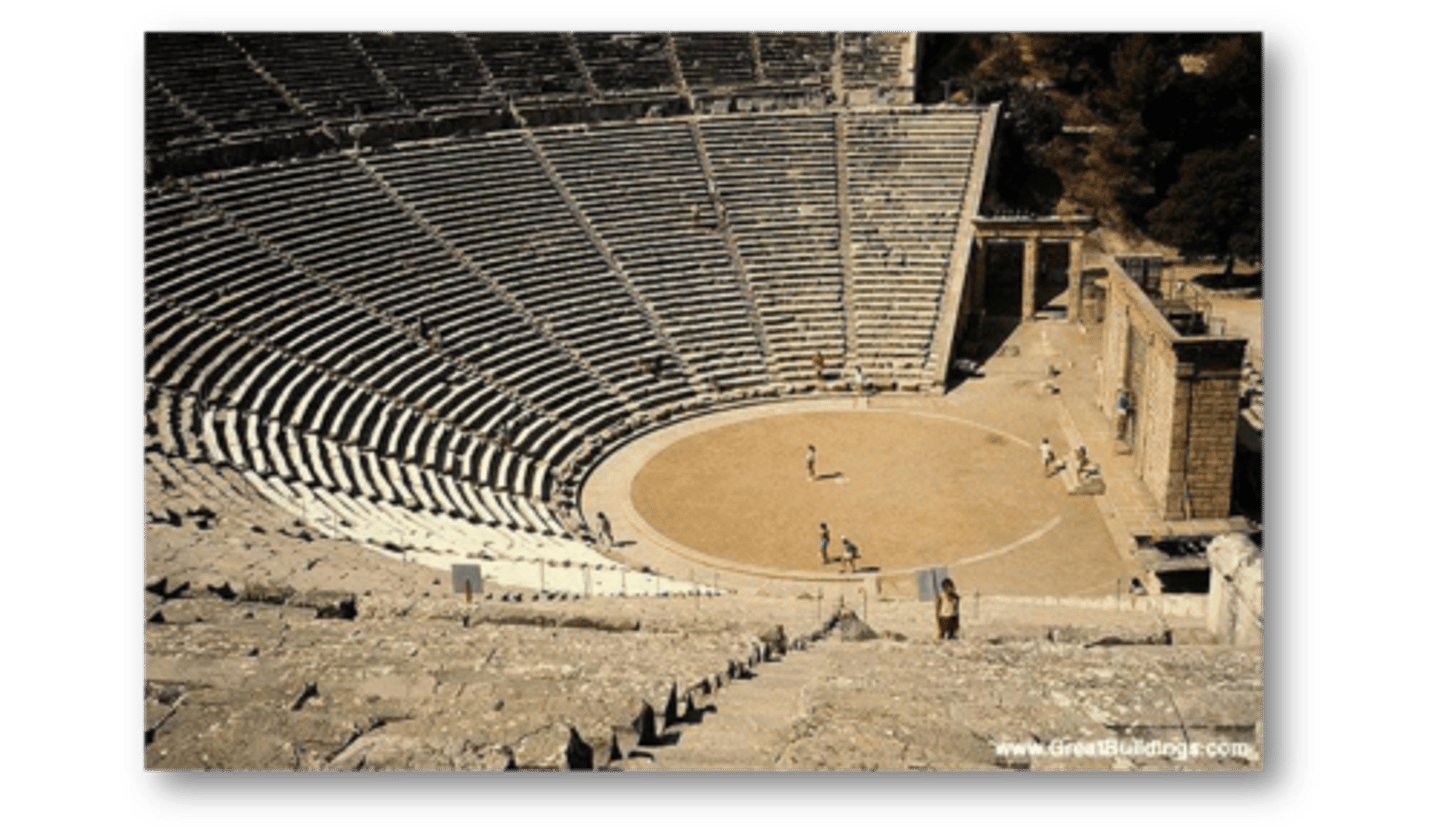
PHOTO: This is the Parthenon at Athens. Classical

PHOTO: This is a metope on the Parthenon
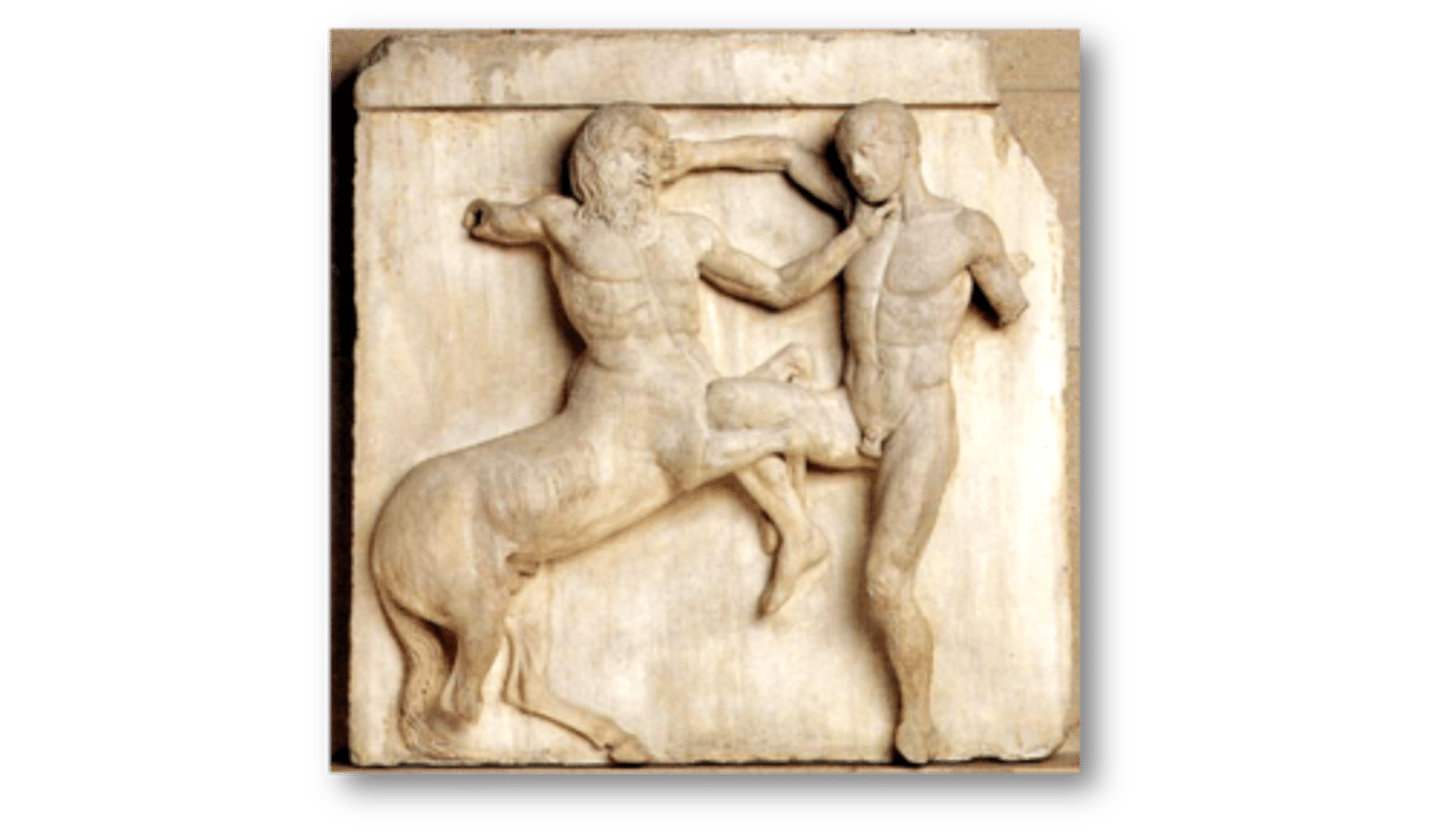
Briefly describe the Hellenistic period
After death of Alexander the Great
323 BCE -146 BCE
- Alexander's successors rule vast areas around the Mediterranean, Near East, and Egypt
- Idea of a cosmopolitan culture --> as in, what if everyone in the world is of the same culture, identity, etc
- Certain cities such as Athens and Alexandria become important hubs and centers of learning
- Period ends when Rome conquers Greece in 146 BCE
What is Hesiod's Theogony about?
It's the story about the creaton and evolution of the universe
Who is Hesiod? When did he exist?
Existed around 700 BCE
Is a farmer and poet from the region of Boeotia
He wrote Theogony (creation work) and Works and Days (work on farming)
What are some characteristics of Theogony?
- Epic poem
- Shorter than Iliad
- Reflects oral tradition
What are some characteristics of oral song?
- Sung by single performer
- Begin by invocating the muses / gods
- Sung in dactylic hexameter
- Repetition of certain phrases
- Epithet "winged-eyed Athena"
- Ring composition
Who are the parents of the Muses?
Zeus + Mnemosyne (memory)
What are the muses?
They are the divine patrons of poetry / dance / other arts.
Led by Apollo, they entertain the gods
What happens at the beginning of the Theogony, after the invocation of the muses?
Gaia (earth), tartaros, and eros (desire) were born. Gaia asexually produces Ouranos (heaven/sky) and they have 12 titans, 3 cyclopes, and 3 hundred-handers.
What happens between Gaia and Ouranos in regards to their children?
Ouranos is jealous of his children, so he stuffs them back into Gaia's body when they're born.
Kronos, Gaia's youngest son, helps his mom. She creates flint to make a sickle, and he uses the sickle to cut off Ouranos' genitals the next time he has sex.
Then, heaven and sky are separated
What is the result of Ouranos' castration?
Ourano's genitals are flung, so the blood that comes from them creates the furies. The actual genitals themselves create aphrodite.
Who are the people Zeus sleeps with? Who are the children?
Metis - Athena (from his head, Metis is swallowed)
Themis (correctness) - Season, justice, fate
Eurynome - Graces
Demeter - Persephone
Mnemosyne - Muses
Leto - Apollo and Artemis
Hera - Hebe, Ares, Eileithyia (asexually produces Hephaestus)
Maia - Hermes
Semele - Dionysus
Not divine --> Alkmene, Heracules
After Kronos overthrows Ouranos, what happens?
Kronos and his sister Rheia create 6 children (the first generation of olympians - Hades, Zeus, Poseidon, Hestia, Hera, Demeter)
Kronos eats his children in fear of them overruling her.
Rheia tricks Kronos into swallowing a stone swaddled as a baby and instead Zeus is grown up sheltered by Gaia on Crete
Zeus grows up and overthrows his father, Kronos
What is the Titanomachy?
It is the fight between the titans and the olympians (plus cyclopes and 100-handed ones).
The battle lasts 10 years
PHOTO: Where is this?
Mount Helikon, where the muses (daughters of Zeus and Memory) live

PHOTO: Who is this?
A muse on Mount Helicon
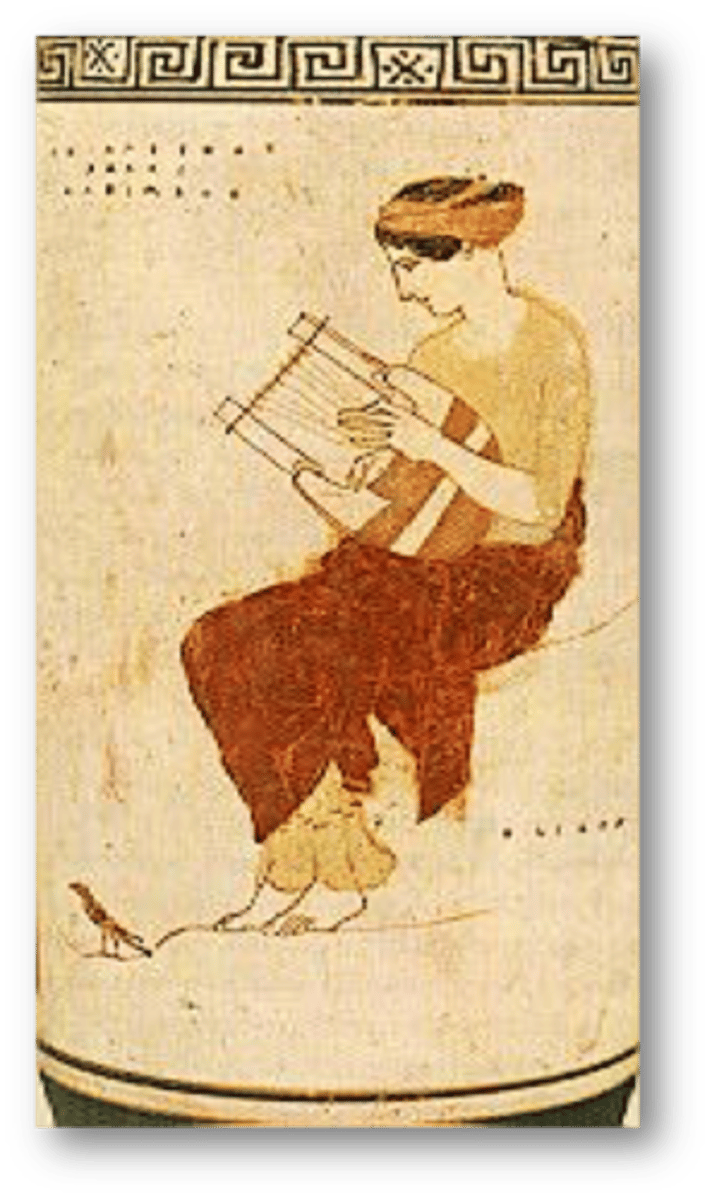
PHOTO: What is happening here?
Painted by Gustave Moreau.
It's Hesiod and the muses
PHOTO: What is happening here? What's the date of this sculpture and it's name?
Aphrodite being born
Ludovisi Throne, 460 BCE
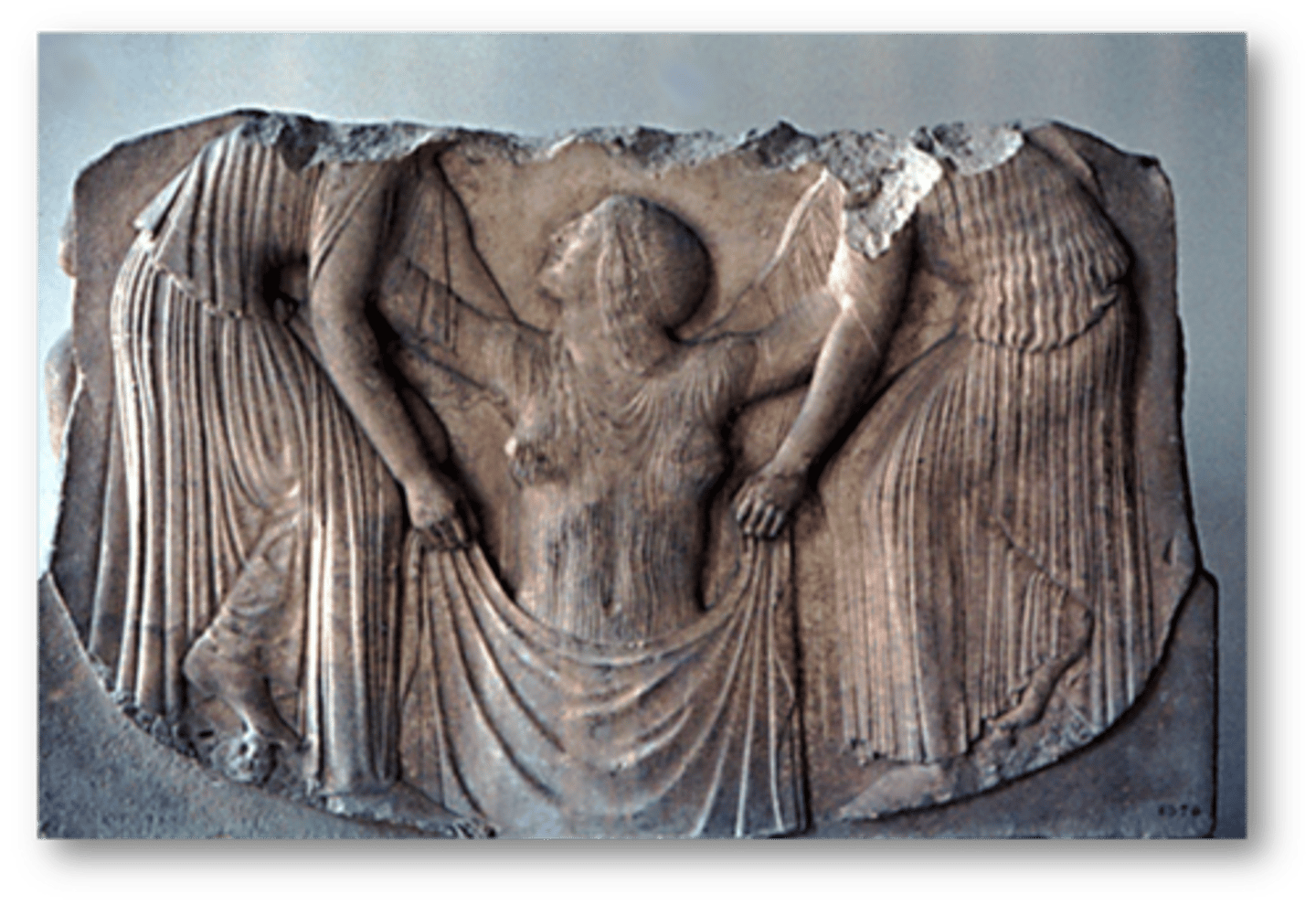
PHOTO: What is this called? Where is it located?
Omphalos at Delphi
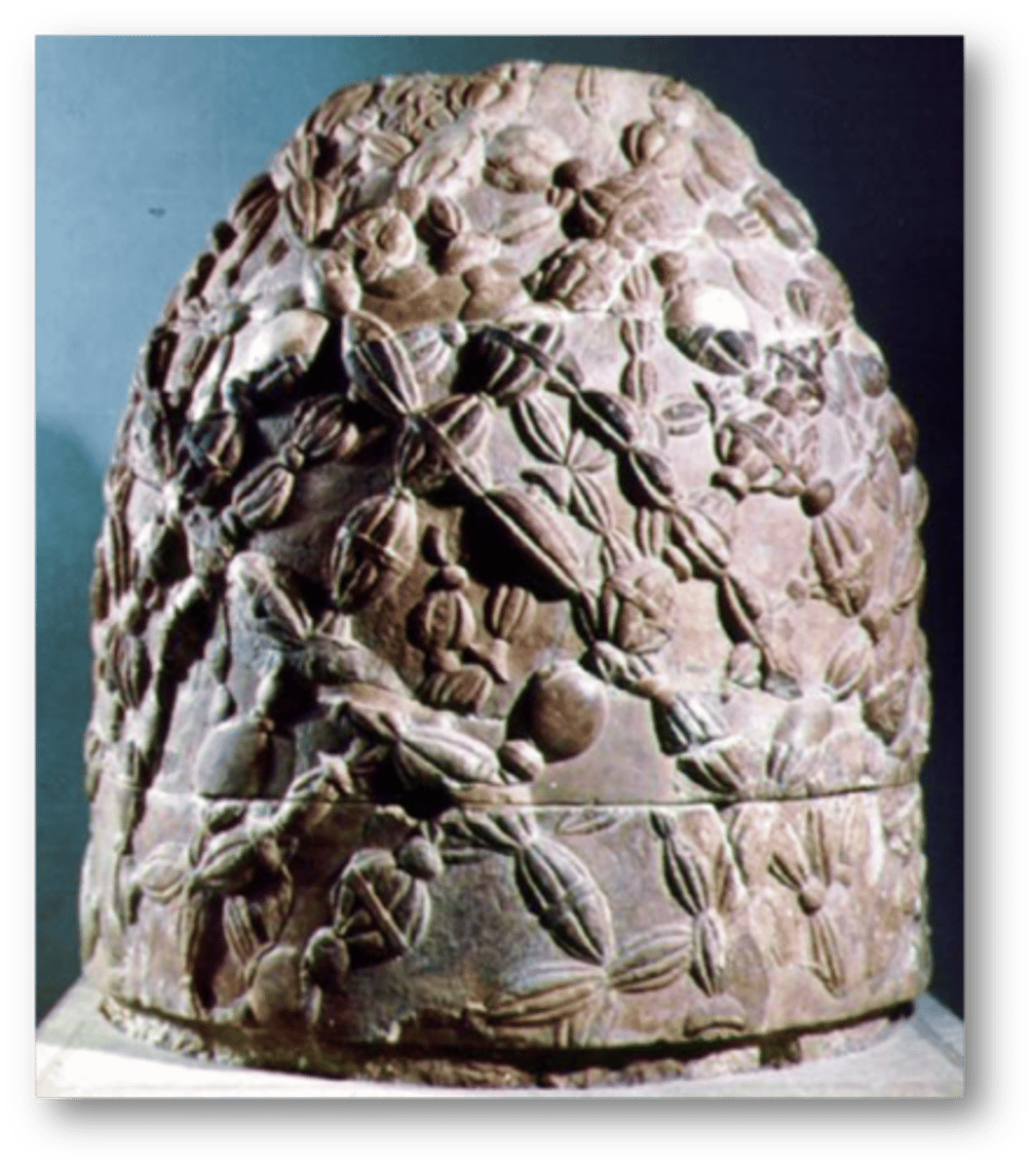
PHOTO: What is happening here?
Zeus and Typhoios
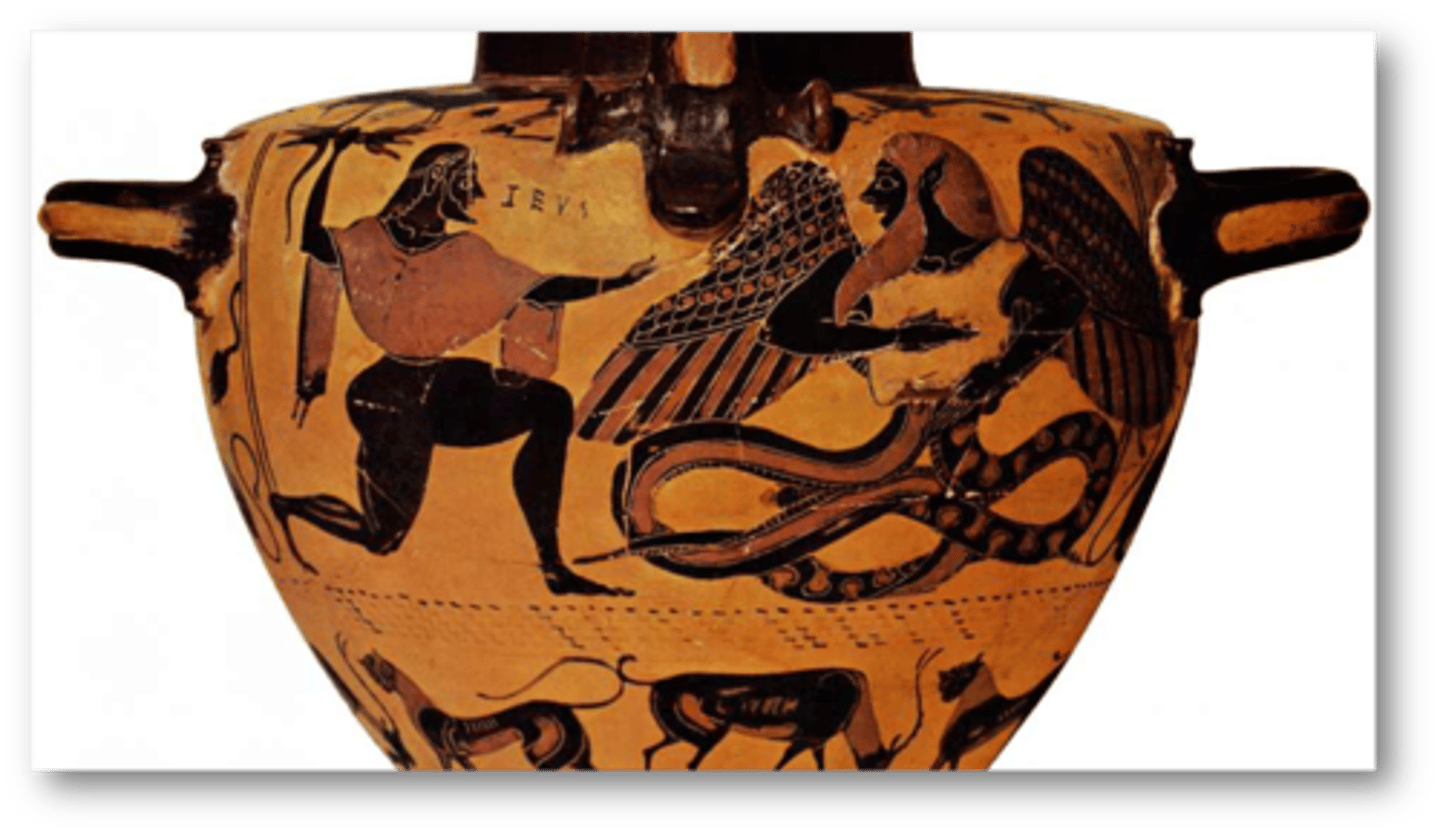
PHOTO: What is happening here?
Zeus throwing a thunderbolt
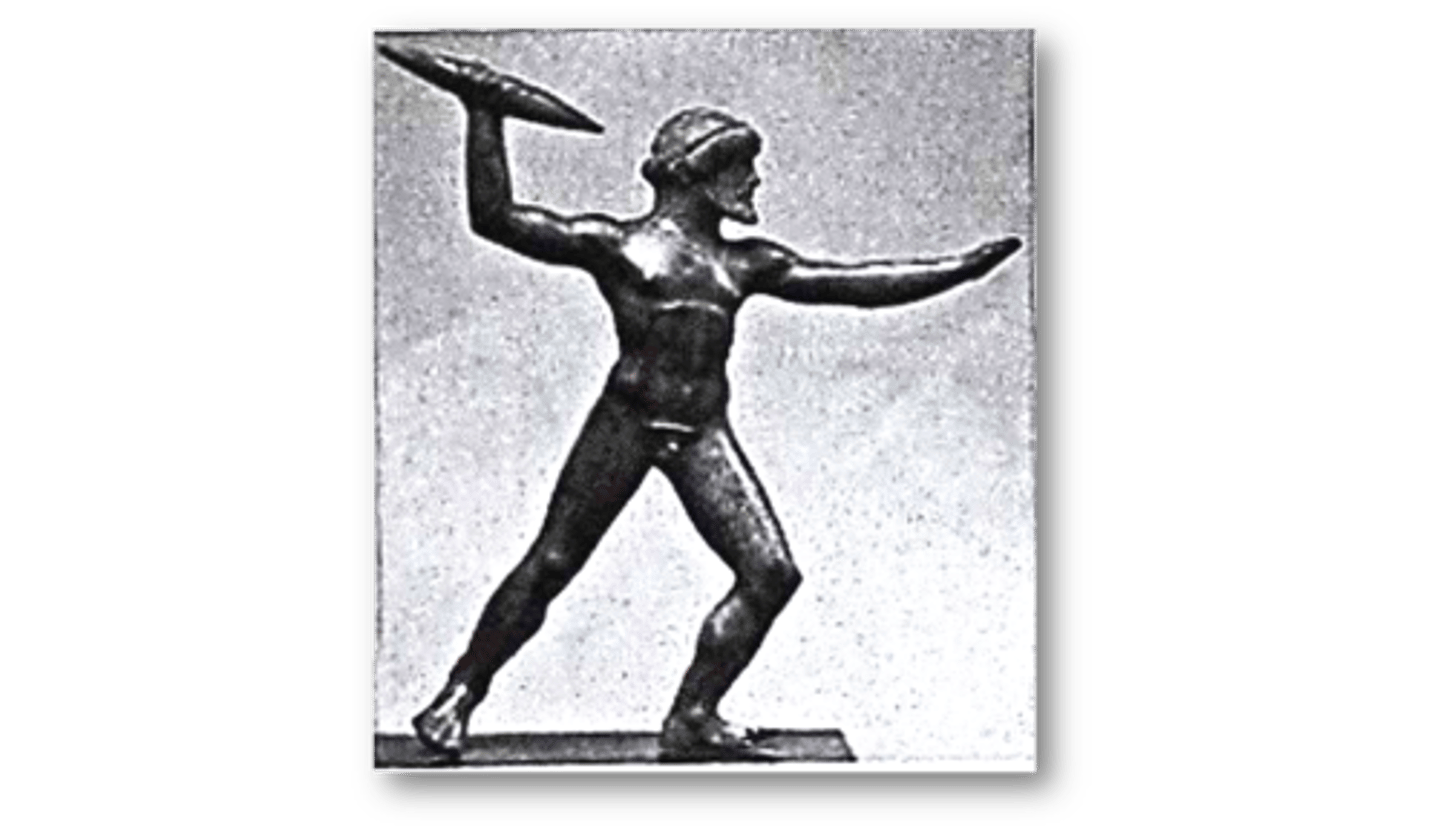
PHOTO: What is happening here?
Athena's birth

PHOTO: What is happening here?
Athena's birth
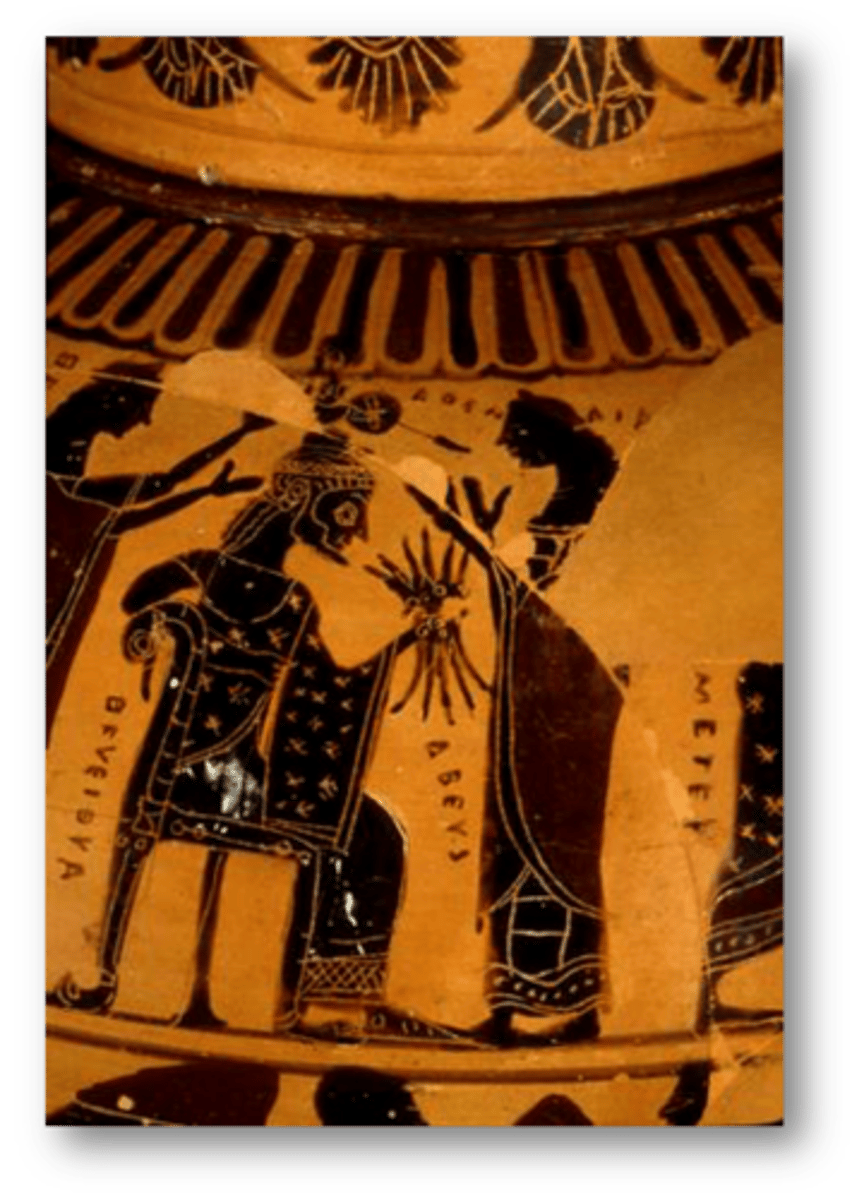
PHOTO: What is happening here?
Athena's birth

PHOTO: What is happening here?
Athena's birth
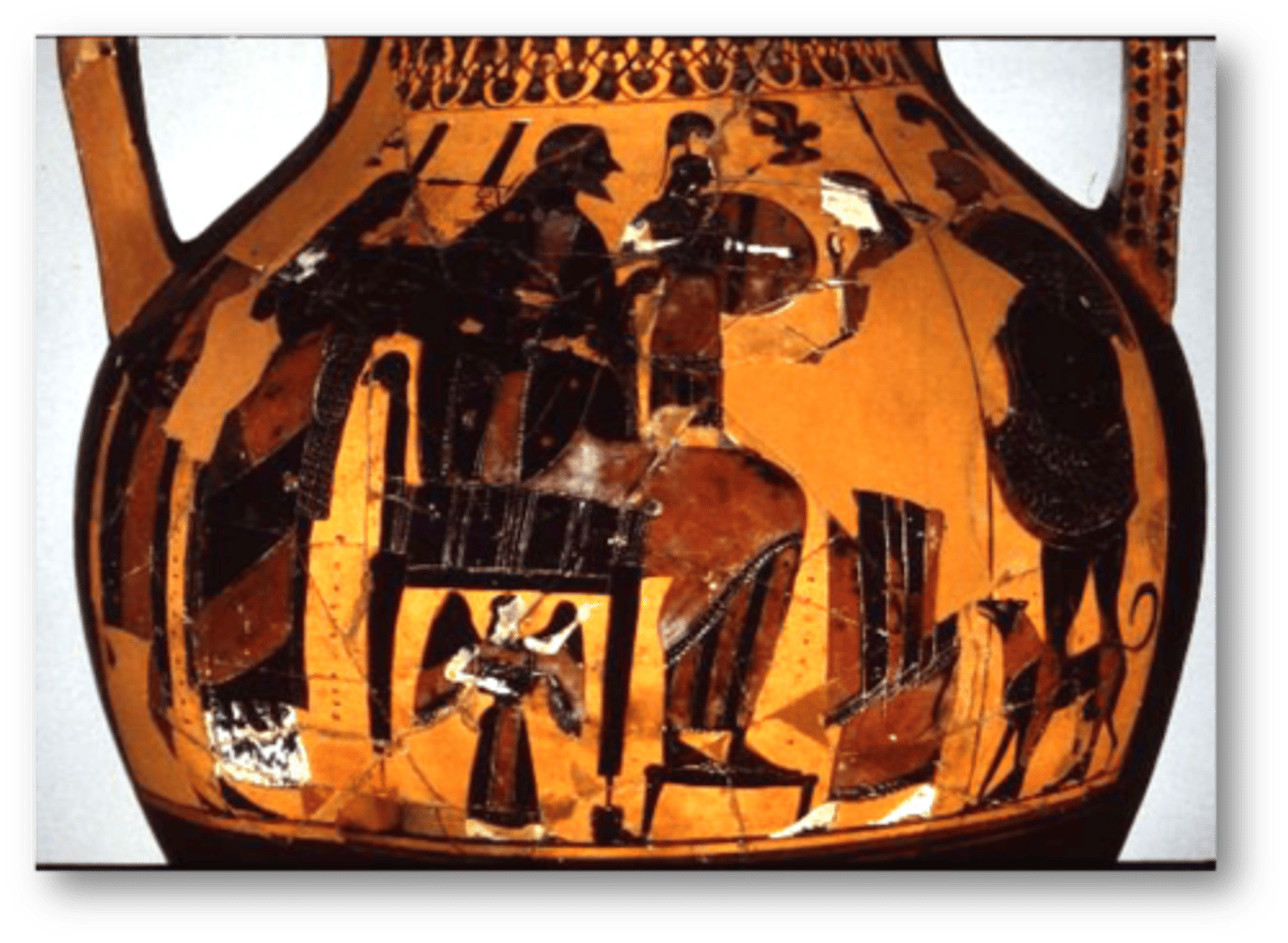
PHOTO: What is happening here?
Hercules marrying Hebe. Holds her by wrist, because possession, not love

Why is Athena a perpetual virgin?
Athena has to be a virgin goddess because if she gave birth to a son, he would be a threat to Zeus. Thus, as long as she remains a virgin goddess, she is Zeus' ally.
Plus, if she was married, she'd be the property of the husband instead of the father.
Where did the first sacrificial feast with gods and humans take place?
Mekone
How many times does Hesiod tell the story of Pandora?
Twice! Both in Theogony and Works and Days
What is the difference between Hesiod's two versions of Pandora?
In one of them we don't get a name?
Who are Prometheus's parents? Siblings?
Parents: Iapetos (a titan) and Clymene (a titan's daughter)
Siblings: Atlas, Menoitios, Epimetheus
What does Prometheus and his siblings have in common?
All offend Zeus in some way and are punished by him.
Prometheus: Gets liver eaten out daily
Atlas: Has to carry the world
Epimetheus: Marries Pandora
Menoitios: No idea
What does Prometheus' name mean?
Forethought
Pro = Fore
Metis = thought
What does Epimetheus, Prometheus' brother, name mean?
After thought
What does Prometheus and his siblings' fates showcase?
That Zeus is the strongest, and that he will get back at you.
Prometheus is a ____ figure
Tricker figure
What does Prometheus do at the sacrifice at Mekone?
He tricks Zeus.
Describe the process of the Greek sacrificial practice.
1. A priest slains an animal at the altar.
2. The animal is cut into small pieces
3. The bones are wrapped in fat and burned on the altar - this way the smoke rose up to the gods
4. The meat was cooked on spits and divided among the people there.
The meal at Mekone is the first sacrificial feast.
What does etiological mean? Give an example of a myth that is etiological.
Etiological: It explains the origins of a custom or object.
The story of the sacrifice at Mekone is etiological, as it explains how sacrifices worked.
Why did Greek people make sacrifices to the gods?
They made these sacrifices in return for a divine favour.
What happened at the sacrifice of Mekone?
Mekone was to set the precedent for how sacrifices between humans and the gods would work.
Prometheus, favouring the humans, was the one who divided up the ox meat for the sacrifice. He wrapped up all the yummy meat in a gross stomach, and made the bones look good by putting it in fat.
Zeus was tricked and chose the bones, which is the obviously lower quality choice. He got mad and punished humans by hiding fire from them.
After, Prometheus gave it to them again, so Zeus got even more mad and chained Prometheus to a rock to have an eagle eat his liver and gave the humans Pandora, who was 'evil'
If in the trick of Mekone, in the Theogony, Zeus saw through Prometheus deception, why did he still choose the bones instead of the meat?
Because there must've been other oral versions of the story where Zeus gets deceived, but since the Theogony is a hymn to Zeus, Hesiod twists it to be like "Zeus knew he was being tricked, but picked the tricked option anyways" to make Zeus seem all powerful
Another reasoning is Zeus needed a reason to be mad at mortal men, so was purposefully tricked to invoke his wrath
What is the hierarchy established at mekone?
Hierarchy:
- Gods
- Humans
- Animals
Gods
- Consume only nectar and ambrosia
- Receive smoke of human sacrifice
Humans
- consume cooked meat of animals at the sacrifice
Animals
- consume raw food
- are the sacrificial victims to be eaten by humans
How does Zeus give punishment for being tricked at Mekone?
He took his anger out on mortal men (instead of Prometheus) and hid fire from them.
How did Prometheus give humans fire?
Stole fire in the form of burning coal but made it look like a fennel stalk
How did Zeus punish Prometheus and mortals after Prometheus steals fire?
Prometheus: Tied to a rock with eagle pecking out his liver
Humans: Get Pandora
PHOTO: What's happening in this photo?
Prometheus is getting his liver eaten by an eagle.

Where is this text from?
"Zeus, angry, withholds fire from mortals, who have benefitted from the disguised portions of sacrificial animal."
Theogony, lines 345-352
What does fire in the Theogony represent?
Technology
What effect does hiding fire from humans have?
1. They're cold af
2. They can't cook meat and puts them at the same levels of animals
3. They can't make sacrifices to the gods, thereby can't ask for divine favours like "protect me from this cold"
Who is Pandora's creator in the Theogony?
Athena and Hephaistos, the lame god born asexually from Hera who spends all his days working
From the Works and Days it's all gods, because everyone contributes something to her creation to make her the most enticing thing ever
What is Pandora made of?
Clay --> Earth and water
What is Pandora's nature?
A BITCH!
Has a bitchy mind and a cheating heart, given to her by Hermes
In her breast are "lies and wheedling words and a cheating heart"
What does Pandora mean?
Pan: Well-endowed
Dora: Gift
What does each god give Pandora?
In Theogony, only Athena and Hephaestus make her. It's only in Works and Days that all the gods come together
Hephaestus: Makes her from and makes her look like a desirable virgin
Athena: Dressed her, taught her embroidery and weaving. Adorned her with accessories (e.g. crown covered with monsters on it, which symbolized her deadly beauty)
Aphrodite: Gave her grace and made her painfully desirable
Hermes: Gave her lies, a bitchy mind, cheating heart, and a voice
Graces: Gold necklaces
Seasons: A flower crown (crown of springtime flowers)
Why is Pandora bad for men?
Because Greeks believed that women did nothing but consume the labours of men. This is because they stayed home and reaped the
benefits of wealth accumulated by the men in their house.
She is beautiful on the outside, but full of trouble on the inside, just like Prometheus' sacrifice at Mekone.
Why is Pandora, and an extension all women, a 'necessary evil'?
Because it is impossible to have children without marrying a woman. You'd want to have children, because they continue our legacy, and ensure that your wealth isn't divided up among other people when you die
What happens after Pandora is created?
Is given as a gift to Epimetheus, Prometheus's brother, even though Prometheus warned him not to take gifts from Olympus
Who names Pandora, Pandora?
Hermes
PHOTO: What's happening in this photo?
Pandora is being created!
Notice the existence of eros, which means sexual desire is present
His presence indicates the importance of sexual desire, and Pandora LOOKS desirable even though internally she's evil
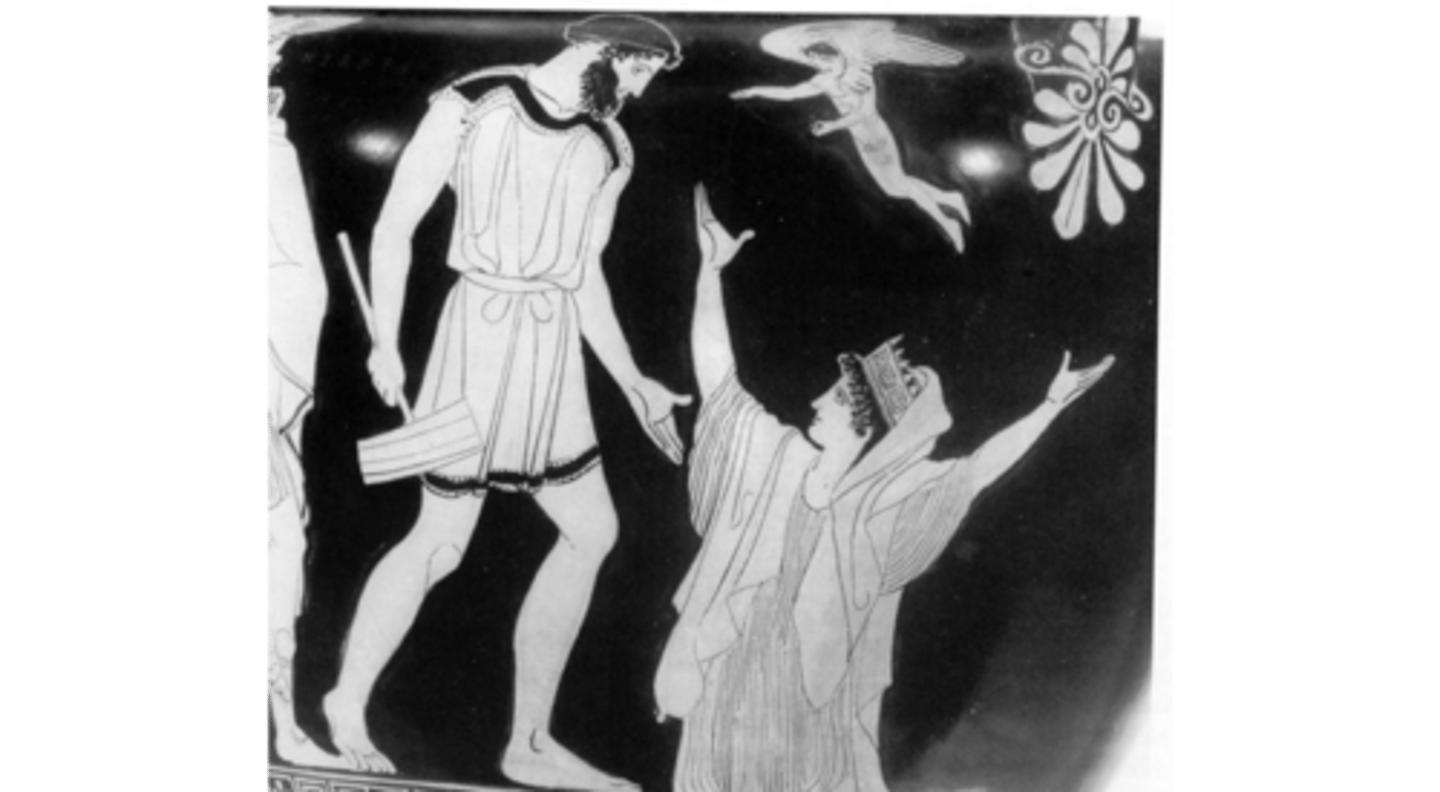
PHOTO: What's happening in this photo?
Pandora is being created by Athena and Hephaestus
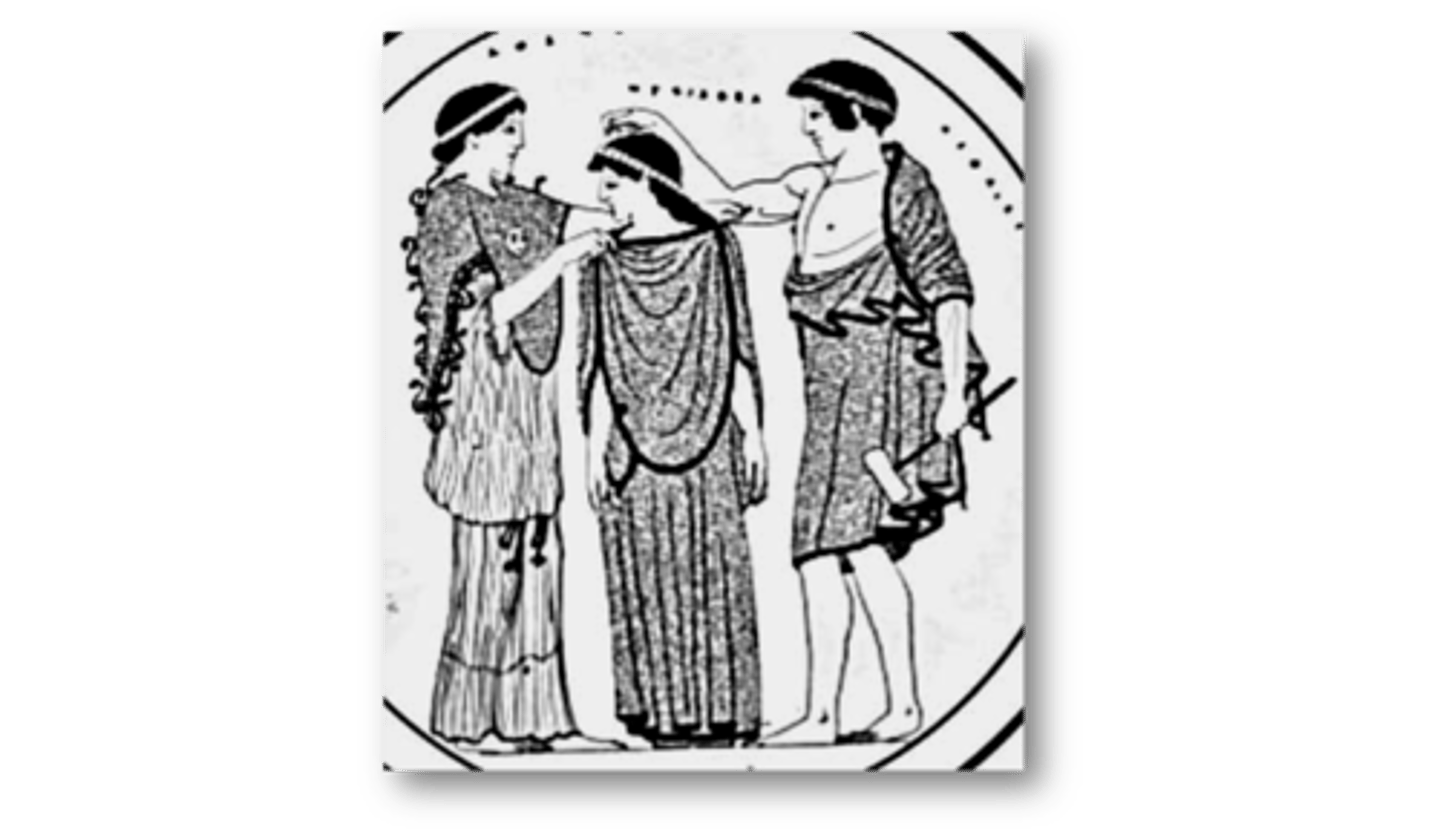
Who did Hesiod write Works and Days to? Why?
His brother Perses, because they were arguing about how to split up their dead father's property and inheritance
Wrote it as a way to get his brother to back off (e.g. talked a lot about the importance of hard work)
What is Works and Days about? How does it tell what it's about?
It's a pessimistic poem on the decline of the human race
It tells the decline of the human race on two accounts
1. Prometheus and Pandora
2. The 5 ages of humankind
What does Hesiod think about strife? E.g. what types are there?
There are 2 types of strife: eris, which is bad, and a good type of strife
Eris (bad strife): Wars, fighting, quarrels, lawsuits
Good strife: Competition, rivalry --> pushing yourself to work harder and increase wealth
Why does Hesiod focus on wealth and hard work when he talks about good strife?
Wants his brother to turn to the 'good kind' of strife.
Basically wants more of his father's inheritance, which his brother clearly took the better half
According to Hesiod's Works and Days, why do humans have to work all the time?
As punishment for Prometheus giving humans fire, Zeus hid how "make a living" from humans
Humans have good (fire), now Zeus must balance that out with bad (pandora/women)
Basically Hesiod is arguing that humans should work hard. AKA his brother Perses should get more wealth by working hard, not through his father's inheritance, and give more of the money to Hesiod
Wants his brother to be more of an honest worker
"Zeus ... went and hid how to make a living, all because shifty Prometheus tricked him."
If Prometheus is seen as intelligent, Epimetheus is ______
Foolish
What is a pithos?
Pandora has one.
It's a clay storage jar, with a bit of a curvy shape. It is decorated to look nice, just like Pandora.
Storage jars were huge, some the size of people.
What happens when Pandora opens her jar / pithos?
All evils come out, except for hope, which is stuck under the lid.
Where is evil introduced into the human world?
At a wedding, because Pandora
What can be gleaned from Pandora's adornment?
She stands there motionless like a doll/puppet. Is more of a trojan horse than a real person.